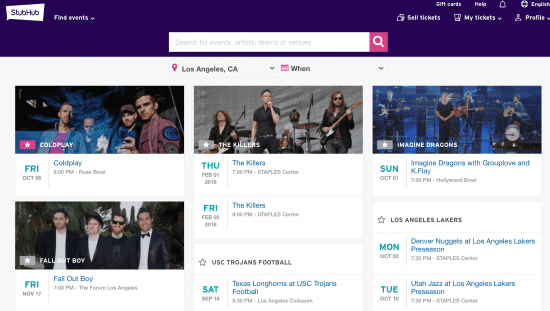Seven predictions to act on for your future marketing plans
The start of 2018 is in sight, So, it’s the start of seasonal predictions about the forthcoming year’s marketing and branding trends.
In this article, I gaze into the crystal ball to make seven predictions relating to 2018’s marketing trends. These cover trends in audience engagement, branding and advertising. For more coverage of digital marketing, see Dave Chaffey’s Marketing trends 2018 article .
Prediction 1: Personalisation gets even more savvy
Marketers have long understood that consumers are preoccupied with one question: “what’s in it for me”? Accordingly, personalization through the use of big data has become one of sales and marketing’s important campaign considerations.
For example, StubHub, an online ticket exchange operated by eBay, reported a 42% improvement with a personalized call to action. IDC forecasts that by the end of 2018, the big data industry will be worth $102bn.
On a practical level, many dynamic sites featuring smart marketing automation have superseded older static site content. (According to Smart Insights Improving Engagement Report 2018, dynamic content insertion is used by 4 in 10 marketers. However, some pundits warn of the danger when excessive personalization becomes less direct, it loses some of its potency. The good news is that digital marketers are fast to respond and adapt to consumer needs and fears. Therefore I predict that personalization will become more subtle, relevant and ultimately savvy.
Prediction 2: Pansexual Marketing
In July 2017, the UK Advertising Standard’s Association report, ‘Depictions Perceptions and Harm’ suggested harmful stereotypes in advertising limit choices, aspirations, and opportunities for children, young people, and adults. The guidelines require brands to adhere to new standards to replace hackneyed stereotypical gender roles and characteristics.
Fearless Girl, a statue in Wall Street created by McCann New York for State Street Global Advisors, is meant to encourage more financial companies to put women in leadership positions. In August, UK Clarks shoes came under fire for launching ‘Dolly Babes’ shoes for girls and ‘Leaders’ for boys. One month later, in a bid to eradicate gender stereotypes, John Lewis removed gender-specific labels from its children’s clothing. (John Lewis also suffered a Twitter backlash).
Despite further anticipated reprisals, towards the end of 2018, brands will introduce more gender-neutral marketing campaigns. I predict that these will feature progressive slogans and hashtags targeted towards cross-gender segments. All these initiatives and more will help lend general support to 2018’s celebrations marking the 100th anniversary of women’s suffrage.
Prediction 3: Grittier #nofilter storytelling
Expect a sharper shift towards live video. In the race to ensure credibility with cynical audiences, during 2018 many brands will aim to be more personable through engaging live video via social media channels like Facebook, Twitter, Instagram, and Snapchat.
Increased user involvement in commenting, liking, videoing, sharing and connecting to events such as featured interviewers with key influencers (such as celebrities) will further help marketing campaigns become exceptionally popular.
To address the global trend towards demanding substance over superficiality (including hostility towards ‘fake news’ in politics and commerce) rather than just slickly produced, yet ultimately bland brand storytelling videos using stock photography, expect content to have a more ‘genuine’ user-produced flavour. Equally, expect B2B brands to produce longer length copy featuring ‘relevant real life’ examples, as opposed to ‘airbrushed’ wishy-washy corporate hogwash.
Prediction 4: Improved management enhances micro-moments
Back in 2015 Google advocated the appeal of micro-moments providing relevant content in real time. Whilst many brands have since adopted the approach, the relentless pressure on marketing departments to push out more and more content has, in far too many cases, diluted its effectiveness. That’s why I predict that in 2018, marketers will further refine micro-moment management in terms of frequency and depth of customer support and experience campaigns across devices. Thanks to a deeper understanding of digital psychology, marketers will become increasingly sophisticated in remaining responsive when delivering timely content, without appearing overly intrusive.
Prediction 5: Social messaging apps dominate social networking
Each day four billion users worldwide use social apps. By 2018 an estimated two billion messages will be sent through so-called over-the-top (OTT) apps.
By next year social messaging will play an even greater role in everyday interactions. It’s all down to social messaging offering a relatively secure instant, real-time connection which is popular with millennials demanding transparency and collaboration. Businesses too will steadily depend on social messaging as an immediate direct communications tool – especially when dealing with overseas customers.
However traditional social networking platforms like Facebook are far from being out of the picture. Facebook ads already lead to brand chats. As a result, customers are solving problems quickly and efficiently. Which brings me to a further prediction: Gazing even further ahead than 2018, I predict that eventually, Facebook will completely integrate WhatsApp (which it has owned since 2014) into a completely new exciting iteration of its service.
Prediction 6: Pop-ups finally burst
Following many years of futurists predicting the definitive demise of pop-up adverts and interstitials, during 2018 more mainstream brand advertising ‘pops’ will finally burst. This move has partly been prompted by Google’s initiative to penalize pop-ups on smartphone. Perhaps penalties for desktop pop-ups will follow in 2018. Gradually, the pop-ups will be replaced by more astutely designed cross-device responsive native advertisements. Providing the new native advertising is transparent, with users appreciating that content is sponsored and is relevant, and campaigns are designed to minimise disruption to the user experience, 2018 is on track to be native advertising’s most successful year yet.
Prediction 7: Tech brands become a channel for spiritual expression
My final prediction concerns a wider aspect of professional marketing. Once only nerds were excited by tech brands. Today everyone is a potential coder. Rather than purely traditional written and graphic creativity delighting marketers, algorithms measuring and targeting response are supposedly just as exhilarating. With so much data overwhelming the senses, 2018 will see marketers turning to technology to take spiritual breathers from the day-to-day grind of spreadsheets and impossible to reach targets. Therefore between meetings with stressed out colleagues, marketers will reach for tech apps offering digital mindfulness programmes or CBT (Cognitive Behavioural Training).
Ah… now breathe…only three months ‘till your new year marketing resolutions.

